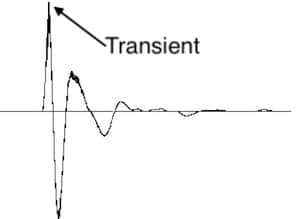What Are Transients and How to Tame Them
Transients are something that get taken for granted by many new music producers, but they shouldn’t. Transients make the difference between whether a sound is punchy or flat.
What’s more, is that many newcomers don’t think to learn how to control them. It’s essential to both understand transients and know how to control them if you want your bassline, drum rack, and other channels to really punch through to your listener.
What Are Transients?
At the start of any sound is a short burst of energy. That burst of energy is the transient of the sound! A classic example engineers throw around when discussing transients are drum hits, and that’s because they have some of the loudest transients of any musical instrument. The whack of the drum stick on a snare, tom drum or cymbal sends a huge burst of sound to the microphone when it hits the drum. That burst of sound is transient information.

Drums may be an exhausting example, but transients are truly everywhere. They’re in the sound of your bass guitar, your saxophone, as well as your keyboard (if you have and play all of these instruments then give our hat is off to you). Not to mention that the consonants of your vocals are also full of transient information.
Transients really are everywhere. They’re in the sound of your bass guitar, your saxophone, as well as your keyboard.
Transient information helps us understand the shape of a sound. In fact, our ears actually interpret sounds differently based on the formation of the transient in the sound.
If the transient of your sound is much louder than the average amplitude of your sound, the transient will be pretty harsh to listen to. In contrast, if the transient is lower than the average amplitude of your sound then it could be underwhelming and flat.
Now let’s double back to our drum example. If your snare drum isn’t very audible in your mix then you have an issue, and it’s probably because its transients are too flat or the transients of another element are too flat. How do you deal with this? Let’s think about it.
You could boost the transients on your snare drum, or
You could compress the transients on your bass…
We highly recommend compressing the transients of your bass first. It’s always better to attenuate rather than boost in most musical situations. If you find your snare still isn’t cutting through your mix then it’s worth boosting the transients of the snare drum, but only when you know that attenuating other elements isn’t working.
What is Loudness?
We’ve thrown the word amplitude around in this article. After all, transients are directly related to loudness, so why not dive in and explain its meaning?
From volume to level, to gain, to amplitude, there’s a number of words used to describe how loud a sound or channel is in your mix. Volume and gain do have significant differences in meaning to one another which you can read about here, but let’s talk about loudness itself.
You’ve probably been living your life thinking that “loudness” and “volume” are the same thing, right? I’m sorry to tell you, but you’ve been living a lie.
Volume is a unit of measurement (dB) of the quantity or power of a sound. When you’re turning the volume knob up on your audio interface, you’re increasing the amount of power that it’s giving the audio you’re running through it.
But loudness is actually subjective to you as it’s based on your personal perception of sound. Frequency content, the duration of the sound, as well as volume of the sound, are all things we need to think about when we’re talking about loudness.
Volume is a unit of measurement (dB) of the quantity or power of a sound, but loudness is consists of many factors including frequency content, the duration of the sound, as well as volume of the sound.
A very easy way to experience how subjective loudness is is to listen to two different frequencies in your monitors or headphones. Make sure your headphones or studio monitors are at the same volume when playing the two frequencies. Play a 1 kHz sine wave and adjust your monitor controller so the volume is comfortable. Now play a 10 kHz sine wave without adjusting the monitor controller. You’ll notice that the two tones do not have the same loudness, even though you haven’t changed the volume.
Another practice you can undertake is to play the 1 kHz for the duration of a hi hat. You can automate this in your DAW of choice, and then play the 1 kHz tone for five seconds. You’ll notice that the tone is louder when left playing for longer. That’s because loudness depends on the volume over time, as well as frequency content!
And what about amplitude? If your sound has a low amplitude then your sound will be quieter. If it has a high amplitude it’s going to be louder. Amplitude is directly related to loudness as it determines the relative loudness of a sound.
Back to Transients
Loudness and transients go hand in hand. You can’t have one without another when it comes to how you perceive audio. Like we said, if the transient of your snare drum is lower than its average amplitude then your snare will sound flat because there’s no initial WHACK.
So, how do we control transients? If your snare isn’t cutting through because the transients on our bass are too prominent, we can use an EQ or compressor to attenuate them. By attenuating your louder transients, you are bringing them in line with the other transients in your track and evening out your track – making it a much more enjoyable listen and making processing and general mixing much easier for yourself.
Controlling transients is actually pretty simple. Using a dynamic or parametric EQ you can isolate where the transients are in your sound and boost them. But when it comes to compressing them, you don’t need to find the transients yourself. A compressor attenuates the dynamic range of your sounds, and thus directly attacks the transients of your sound (as they’re at the peak of your sound).
Now that you understand what transients are and how you can hone your own, it’s time for you to jump into your sample library and find a sound that needs some work. What’s that? No sound is grabbing your attention?
The sampling revolution has risen in popularity and shaped music since the early 1970s. Sample culture continues to transform how millions of artists and producers do their thing in DAWs.
You too can break conventional norms, challenge the status quo, and open Pandora’s box of sound design.
Mixxed works with a growing number of sample labels and contributors to provide you with an affordable sample subscription service that’s more accessible than any before.
You’ll have access to our growing catalogue of loops, one-shots and sound effects that you can browse, download and keep forever for less than $3 a month.
Sign up today to find your sound!
